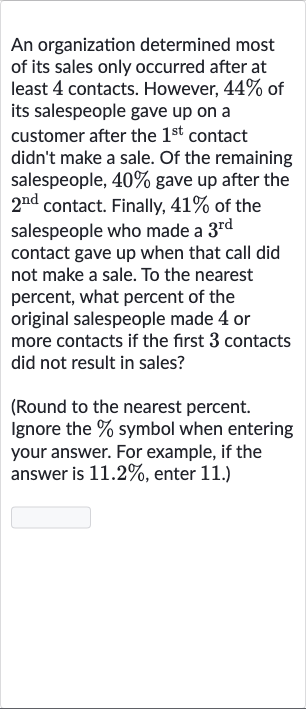AI tutor
Welcome to Bytelearn!
Let’s check out your problem:

An organization determined most of its sales only occurred after at least contacts. However, of its salespeople gave up on a customer after the contact didn't make a sale. Of the remaining salespeople, gave up after the contact. Finally, of the salespeople who made a contact gave up when that call did not make a sale. To the nearest percent, what percent of the original salespeople made or more contacts if the first contacts did not result in sales?(Round to the nearest percent. Ignore the symbol when entering your answer. For example, if the answer is , enter .)
Full solution
Q. An organization determined most of its sales only occurred after at least contacts. However, of its salespeople gave up on a customer after the contact didn't make a sale. Of the remaining salespeople, gave up after the contact. Finally, of the salespeople who made a contact gave up when that call did not make a sale. To the nearest percent, what percent of the original salespeople made or more contacts if the first contacts did not result in sales?(Round to the nearest percent. Ignore the symbol when entering your answer. For example, if the answer is , enter .)
- Calculate st Contact Percentage: Calculate the percentage of salespeople who gave up after the st contact. of salespeople gave up after the st contact, so of the salespeople continued to the nd contact.Calculation:
- Calculate nd Contact Percentage: Calculate the percentage of salespeople who gave up after the nd contact.Of the remaining , gave up after the nd contact. So, of the salespeople continued to the rd contact.Calculation:
- Calculate rd Contact Percentage: Calculate the percentage of salespeople who gave up after the rd contact.Of the remaining , gave up after the rd contact. So, of the salespeople continued to the th contact.Calculation:
- Round Final Percentage: Round the final percentage to the nearest percent.The percentage of salespeople who made or more contacts is approximately , which rounds to when rounded to the nearest percent.Calculation:
More problems from Find what percent one number is of another: word problems
QuestionGet tutor help
QuestionGet tutor help
